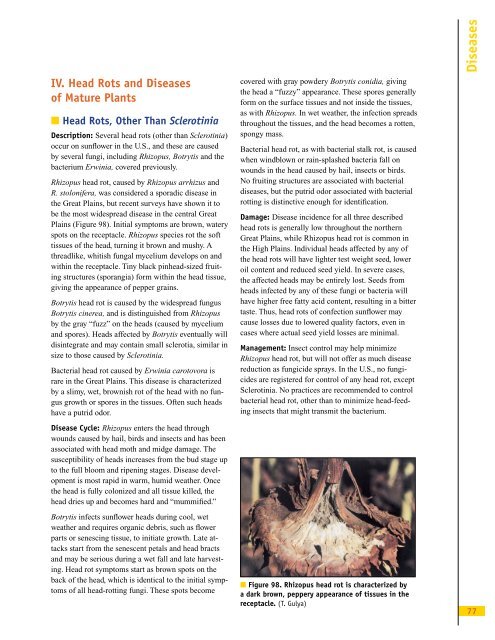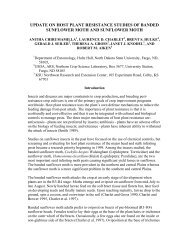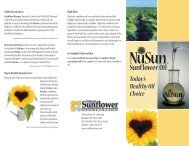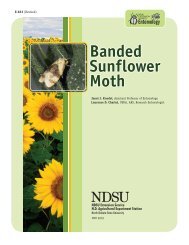Sunflower Production - NDSU Agriculture - North Dakota State ...
Sunflower Production - NDSU Agriculture - North Dakota State ...
Sunflower Production - NDSU Agriculture - North Dakota State ...
You also want an ePaper? Increase the reach of your titles
YUMPU automatically turns print PDFs into web optimized ePapers that Google loves.
IV. Head Rots and Diseasesof Mature Plants■ Head Rots, Other Than SclerotiniaDescription: Several head rots (other than Sclerotinia)occur on sunflower in the U.S., and these are causedby several fungi, including Rhizopus, Botrytis and thebacterium Erwinia, covered previously.Rhizopus head rot, caused by Rhizopus arrhizus andR. stolonifera, was considered a sporadic disease inthe Great Plains, but recent surveys have shown it tobe the most widespread disease in the central GreatPlains (Figure 98). Initial symptoms are brown, wateryspots on the receptacle. Rhizopus species rot the softtissues of the head, turning it brown and mushy. Athreadlike, whitish fungal mycelium develops on andwithin the receptacle. Tiny black pinhead-sized fruitingstructures (sporangia) form within the head tissue,giving the appearance of pepper grains.Botrytis head rot is caused by the widespread fungusBotrytis cinerea, and is distinguished from Rhizopusby the gray “fuzz” on the heads (caused by myceliumand spores). Heads affected by Botrytis eventually willdisintegrate and may contain small sclerotia, similar insize to those caused by Sclerotinia.Bacterial head rot caused by Erwinia carotovora israre in the Great Plains. This disease is characterizedby a slimy, wet, brownish rot of the head with no fungusgrowth or spores in the tissues. Often such headshave a putrid odor.Disease Cycle: Rhizopus enters the head throughwounds caused by hail, birds and insects and has beenassociated with head moth and midge damage. Thesusceptibility of heads increases from the bud stage upto the full bloom and ripening stages. Disease developmentis most rapid in warm, humid weather. Oncethe head is fully colonized and all tissue killed, thehead dries up and becomes hard and “mummified.”Botrytis infects sunflower heads during cool, wetweather and requires organic debris, such as flowerparts or senescing tissue, to initiate growth. Late attacksstart from the senescent petals and head bractsand may be serious during a wet fall and late harvesting.Head rot symptoms start as brown spots on theback of the head, which is identical to the initial symptomsof all head-rotting fungi. These spots becomecovered with gray powdery Botrytis conidia, givingthe head a “fuzzy” appearance. These spores generallyform on the surface tissues and not inside the tissues,as with Rhizopus. In wet weather, the infection spreadsthroughout the tissues, and the head becomes a rotten,spongy mass.Bacterial head rot, as with bacterial stalk rot, is causedwhen windblown or rain-splashed bacteria fall onwounds in the head caused by hail, insects or birds.No fruiting structures are associated with bacterialdiseases, but the putrid odor associated with bacterialrotting is distinctive enough for identification.Damage: Disease incidence for all three describedhead rots is generally low throughout the northernGreat Plains, while Rhizopus head rot is common inthe High Plains. Individual heads affected by any ofthe head rots will have lighter test weight seed, loweroil content and reduced seed yield. In severe cases,the affected heads may be entirely lost. Seeds fromheads infected by any of these fungi or bacteria willhave higher free fatty acid content, resulting in a bittertaste. Thus, head rots of confection sunflower maycause losses due to lowered quality factors, even incases where actual seed yield losses are minimal.Management: Insect control may help minimizeRhizopus head rot, but will not offer as much diseasereduction as fungicide sprays. In the U.S., no fungicidesare registered for control of any head rot, exceptSclerotinia. No practices are recommended to controlbacterial head rot, other than to minimize head-feedinginsects that might transmit the bacterium.■ Figure 98. Rhizopus head rot is characterized bya dark brown, peppery appearance of tissues in thereceptacle. (T. Gulya)Diseases77










